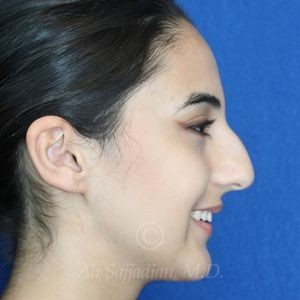

Rhinoplasty surgeries differ in the approach and techniques used based on the ethnic nasal structure of each patient. Performing nasal surgery on people not of Caucasian descent requires the surgeon to improve both the appearance and functionality of the nose while preserving the features of their culture (ethnic rhinoplasty).
People of Middle Eastern descent will have a Middle Eastern rhinoplasty to account for their genetic nasal structure. Dr. Sajjadian has performed rhinoplasties on patients from Yemen, Iran, Iraq, Saudi Arabia, Israel, Bahrain, Kuwait, and Turkey, which makes him a great candidate for your Middle Eastern rhinoplasty.
Preserving Your Heritage
Having a surgeon who is familiar with the unique and cultural aspects of a Middle Eastern nose is extremely important. Retaining the authenticity of your heritage is crucial for embracing your ethnic and natural appearance. Dr. Sajjadian’s extensive experience and deep understanding of the anatomy of Middle Eastern facial structures allows him to bring balance and harmony to your features.
What Will a Middle Eastern Rhinoplasty Correct?
The focus of a rhinoplasty is to change the appearance of the nose from a cosmetic standpoint and help with the functionality of the nose. Middle Eastern rhinoplasties specifically focus on the unique nasal construction present in patients from the Middle East. Specific issues that may be fixed include:
- Nasal hump
- Bulbous, downward-pointing tip
- Thick skin
- Long, droopy nose
- Wide tip
Preparing For Your Consultation
The first step to a Middle Eastern Rhinoplasty is scheduling a consultation with triple board-certified plastic surgeon, Dr. Sajjadian. During the consultation, you will discuss what is bothering you, what you are looking to change, and functional or aesthetic goals. Dr. Sajjadian’s experience with Middle Eastern nasal anatomy and rhinoplasty allows him to prepare you for what to expect with this procedure. Although Dr. Sajjadian will give advice and recommendations on what to achieve through rhinoplasty, it is important that you address what you are looking to change and see after the procedure. Being prepared with questions for Dr. Sajjadian is crucial to ensure you are aware of everything that will be taking place during this procedure. The consultation is the time to discuss your medical history and any other surgeries you have done prior so that the surgical experience can be as safe as possible.
Open Technique or Closed Technique?
Depending on the complexity of the rhinoplasty, an open or closed technique can be applied. During your consultation, Dr. Sajjadian will determine which technique will provide the best results for your case. Depending on the patient’s needs and level of intricacy, Middle Eastern rhinoplasty can be done using different techniques.
Open Rhinoplasty- Open rhinoplasty is meant for patients looking for more dramatic revisions. A small incision is made across the strip of tissue that separates the nostrils, allowing the surgeon to access a large portion of the nasal structure. Having an open rhinoplasty will increase the risk of post-operative swelling and scarring because of the more rigorous approach.
Closed Rhinoplasty- Closed rhinoplasty is meant for patients trying to make minimal changes. All incisions are made inside the nose, and there are no external incisions. The surgeon cannot access the majority of the nasal structure, which limits the amount of work that can be done. However, there will be less post-operative swelling and scarring.
Recovery After Middle Eastern Rhinoplasty
Recovery after a Middle Eastern Rhinoplasty will take up to several months before you will be able to return back to work, school, and daily activities such as exercise. The nose will be tender, sore, swollen, bruised, or numb after the surgery. Dr. Sajjadian will provide the pertinent information and pain medication to aid you through the recovery process. To limit swelling, you will need to keep your head elevated after surgery to help with lymphatic flow. The cast and splints may be removed one-week post-operation, but taping the nose is crucial for the following four months. Taking vitamins will also help your body’s natural healing process.
Picking the Right Surgeon
If you are looking to improve the appearance and performance of your nose while maintaining your unique Middle Eastern appearance, rhinoplasty is meant for you. Dr. Sajjadian’s individualized strategies and knowledge allow him to enhance the proportionality and harmony of all your facial features. It is important for the surgeon to have an in-depth understanding of Middle Eastern nasal structures so they will know what to address when conducting the surgery. The same approach cannot be applied to patients of different ethnicities, which makes this procedure extremely patient-specific. His plan to address your specific wants and needs with a natural approach has made him successful thus far. Rhinoplasty is one of the most complex and tedious procedures, so it is crucial to have a board-certified plastic surgeon like Dr. Sajjadian conduct this life-changing surgery for you!
Contact us today to get started. Also, be sure to review Dr. Sajjadian’s before and after photo gallery to see some of his patients’ amazing results!
